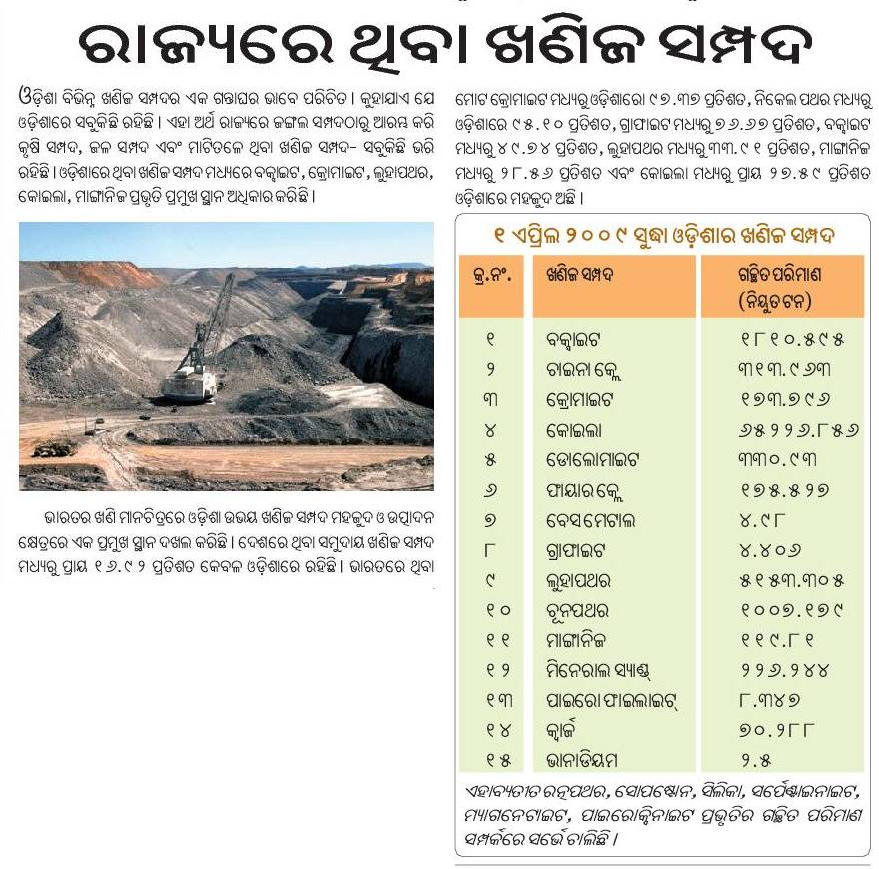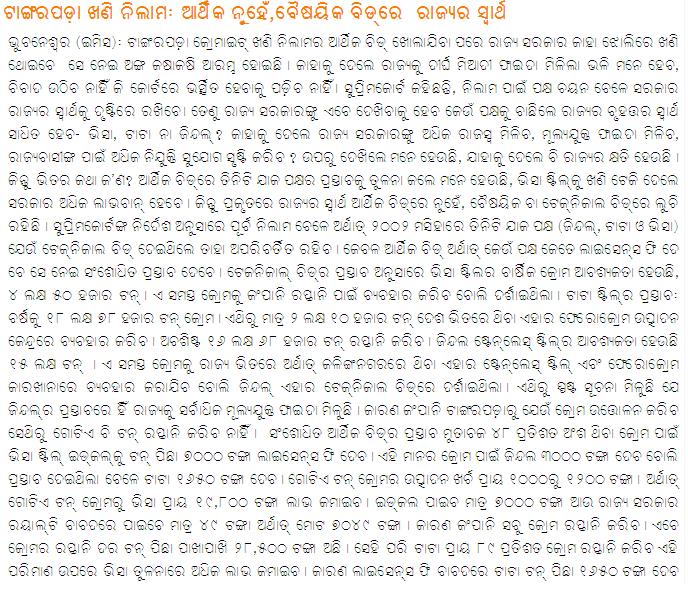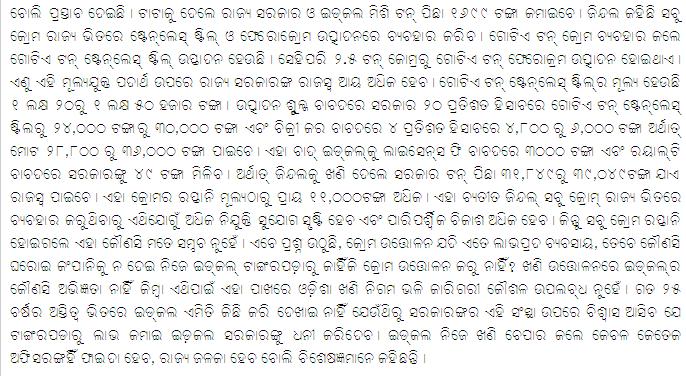Archive for the 'Chromite' Category
Center to approve Ad Valorem royalty on non-coal minerals: Wall Street Journal
Ad Valorem, Bauxite, Chromite, Gemstones, Granite, Iron Ore, MINES and MINERALS, Mining royalty 4 Comments »(Thanks to Umashankar babu for the tip.)
Following is an excerpt from a report in the Wall Street Journal.
India’s federal government has approved an increase in mining royalties for various minerals including iron ore, copper, zinc and lead, government officials said Wednesday.
Two mining ministry officials, who didn’t want to be named, told Dow Jones Newswires that India’s cabinet committee on economic affairs has approved the proposal for changes in royalties on minerals other than coal, and a formal notification with immediate effect is expected this week.
… The change in rates will increase states’ annual revenue from royalties to 46.3 billion rupees ($968.6 million) from 22.88 billion rupees.
… The officials said the government will levy a 10% value-added or ad valorem royalty on iron ore mining.
For iron ore miners, the new royalty will mean switching to a tax regime under which they will be charged based on the market value of the minerals compared with the existing system of flat rates based on weight, the officials said.
At present, the government charges a fixed royalty of up to 27 rupees a metric ton on different grades of iron ore.
Iron ore spot prices in the local market may rise by about 10% in the near future, … said Rahul Baldota, … But he added that iron ore producers in India, the world’s third-largest supplier of the commodity, will absorb the cost for exports in order to remain competitive.
… India already charges value-added royalty rates for zinc, copper and lead, but the rates charged will now increase.
The government will charge an 8% royalty on zinc ore, up from 6.6% earlier, while the rate on copper will rise to 4.2% from 3.2%. The royalty on lead ore will go up to 7% from 5%.
On bauxite used for other than alumina and aluminum extraction and exports, a royalty of 25% will be charged. For use in alumina and aluminum extraction, the rate will be 0.5%. Previously, no royalties were charged.
Orissa has 98% of India’s chromite deposit; only 3.27% explored
Chromite, Dhenkanal, Jajpur, Jajpur Rd- Vyasanagar- Duburi- Kalinganagar 2 Comments »Following is excerpted from a report in Business Standard.
Though Orissa has 183 million tonnes of chrome ore, constituting 98 per cent of the total chrome deposits in the country, only 3.27 per cent of this, which comes to about 6 million tonne, has been fully explored till date.
To expedite the exploration and exploitation of chrome reserves in the state, the government has granted mining leases to 15 companies including Ferro Alloys Corporation (Facor) and Balasore Alloys.
Of the total chrome reserves in Orissa, Sukinda area in Jajpur district has the lion’s share of 173 million tonne (mt). This includes low grade chrome.
The places in Sukinda where the chrome deposits are found are Kamarda (2 mt), Saruabili (9 mt), Sukrangi (7.5 mt), Kaliapani (25 mt), Bhimatanger (98 mt), Kalarangi (0.5 mt) and Chingudipal and Tailangi (13 mt).
Out of the total deposits found in Sukinda area, 18 million tonne are of inferior quality, says the state steel and mines minister, Raghunath Mohanty said.
The Kamakshyanagar in Dhenkanal district, which adjoins Sukinda valley, has about 4.42 million tonne reserve of chromite in locations like Sandhasar, Tulasiposhi, Haladigunda and Kathapal. The estimated reserves at Kathapal are 2 million tonne.
Mohanty said, the total chromite reserve of the state is estimated at 183 million tonne, out of which 177.42 million tonne occur in Sukinda and Kamakshyanagar area.
Tangarpada auction: Combining financial and technical bids to determine the winner (Sambada)
Chromite, Mine auction, Mining royalty, Odisha govt. action, Sambada (in Odia), Supreme Court, Value Addition Comments Off on Tangarpada auction: Combining financial and technical bids to determine the winner (Sambada)In http://www.orissalinks.com/orissagrowth/archives/1616 we discussed a report regarding auctioning of minerals. The following article in Sambada illusrtates with numbers that the best way to go would be to decide the winner of the auction based on evaluating the financial and technical bid together and determining which one offers the state the maximum revenue. (Later when time permits I will translate the article into English.)
Auctioning of minerals is the way to go?
Chromite, Iron Ore, MINES and MINERALS, Odisha govt. action, OMC, Value Addition Comments Off on Auctioning of minerals is the way to go?The following excerpts from a news item from tathya.in illustrates the difference between the state’s income due to only royalties and through auction.
In 2002 the IDCOL made an abortive attempt to give away the mines to Jindal Stainless at a throw away considerations ignoring higher bids by Tata Steel and Visa Industries.
The ill-conceived move by the bureaucrats was foiled by the Orissa High Court, which passed adverse comments regarding the Government of Orissa attempt to compromise public interest in the deal.
Both the State Government and IDCOL appealed before the apex court to get relief with considerable cost and time.
Supreme Court’s order for re-bidding how ever has now materialized.
To the amazement of every one Jindal Stainless which had offered a sum of Rs.38 per ton has now come up with a bid of Rs.3000 per ton for ore having 48 per cent chromium.
And on average they have offered per ton Rs.900.
Visa Industries has out bid Jindal Stainless with an offer of Rs.7000 per ton of chrome having 48 per cent of chromium content.
Even assuming the changes in the commodity prices which have taken place in last 5 years is too much than the price offered earlier.
The colossal loss to the flagship Public Sector Undertaking (PSU), IDCOL can be well imagined if the Jindal Stainless had succeeded in 2002.
Now with opening the financial bids of the participants, it underscores the point that the State Government’s Policy for leasing out the mineral resources of the state is faulty and not at all in the best interest of the state, said a financial analyst.
To take the advantage of high price in demand of metals and minerals in the international market, corporate giants and multinationals like POSCO, Arcelor- Mittal, Essar, Vedanta, Jindal, Bhusan and many others are flocking to Orissa to corner mining leases.
The State Government … Yet they do not learn from the Tangarpada experience.
… Under the MMDR Act, mines can be reserved for the PSUs and leased out to the State owned companies like IDCOL and OMC.
These PSU can auction the mines among the credible parties after floating world tender for value addition and derive bonanza.
Till date no body knows about the “Policy of Value Addition” of the Government of Orissa.
The Policy should come up immediately and it should be implemented in letter and spirit for the interest of the state.
The positive changes of Policy will not effect industrialization, but it will give substantially higher rate of revenue to the state exchequer as demonstrated in case of Tangarpada.
The state’s entire requirement of funds for eradicating poverty and developing the state can be generated with the policy change, said a former Union Minister.
However there is no effort in this direction.
… Instead of Centre bashing the State Government should make efforts to maximize revenue from mineral resources through PSU mode, observed a former Secretary of the Government of India.
Definitely the state can earn much more on just the minerals by leasing it to state companies like OMC and IDCOL and then letting those companies auction the mineral. The possible negative of completely following that approach, especially with respect to iron ore, is that the winner of the auction can then take the ore and set up plants in other states. If that happens Orissa will lose out on the side developments associated with plants such as infrastructure building, jobs and the tax that the state can get from the companies.
What the state should do is to try for the best of both worlds. I.e., offer other facilities and enticements to keep the companies in the state but go the route of auction. What other facilities and enticements can the state offer? Orissa being on the coast, availability of ports nearby is an important factor and it is good that the state is working on the development of many ports and railway lines to those ports. Easy availability of land for the companies will help. More thoughts need to be put in this direction.
There is a chance that some companies will not set up shop in Orissa under these conditions; but these days there seems to be a lot of companies who want to set shop. So perhaps the time has come for the state to change its approach of leasing mines to attract companies to auctioning minerals via IDCOL and OMC and using other methods to attract value addition companies.
Sukinda valley: 4th most polluted area in the world according to US-based Blacksmith institute
Chromite, Dhenkanal, Jajpur, Jajpur Rd- Vyasanagar- Duburi- Kalinganagar, Kalinganagar corridors, Mine related pollution, MINES and MINERALS, State Bureaucrats (IAS, OAS, etc.), Websites of Interest 2 Comments »Following is an excerpt from a Telegraph report.
Sukinda valley in Orissa�s Jajpur is one of the most polluted places in the world, according to a report by the US-based Blacksmith Institute.
The institute provides solutions to pollution-related problems.
From India, Sukinda has ranked fourth and Vapi, a 400km industrial belt in Gujarat, is fifth on the list of 10 most polluted places.
The valley, about 140km from here, is spread across Dhenkanal and Jajpur districts and has the largest chrome ore deposit in the country — 97 per cent of India�s reserves. Mining is done by the opencast method.
According to the report, �12 mines continue to operate without any environmental management plans and over 30 million tonnes of waste rock are spread over the surrounding areas. The mines discharge untreated water into the river. This area is also flood-prone, resulting in further contamination of the waterways.�
The problem is �beyond the means of the state to solve�.
Environmentalists said the report is damning evidence of the impact rampant mining has on Orissa.
… However, chairman of Orissa State Pollution Control Board L.N. Patnaik described the report as �silly�. �I see a lot of personal agenda behind the report. It is a design to stop mining activities. If there is mining, there would be some air pollution. But to say that Sukinda is one of worst polluted places in the world is ridiculous,� he said.
The comment by OSPC Board Chairman Mr. Patnaik is outrageous. He should talk about what steps his organization is taking, if any, to minimize pollution. Instead of saying that he talks about personal agenda. Does that mean OSPC is not taking any steps to reduce pollution?



